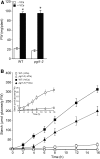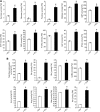Arabidopsis Responds to Alternaria alternata Volatiles by Triggering Plastid Phosphoglucose Isomerase-Independent Mechanisms
- PMID: 27663407
- PMCID: PMC5100789
- DOI: 10.1104/pp.16.00945
Arabidopsis Responds to Alternaria alternata Volatiles by Triggering Plastid Phosphoglucose Isomerase-Independent Mechanisms
Abstract
Volatile compounds (VCs) emitted by phylogenetically diverse microorganisms (including plant pathogens and microbes that do not normally interact mutualistically with plants) promote photosynthesis, growth, and the accumulation of high levels of starch in leaves through cytokinin (CK)-regulated processes. In Arabidopsis (Arabidopsis thaliana) plants not exposed to VCs, plastidic phosphoglucose isomerase (pPGI) acts as an important determinant of photosynthesis and growth, likely as a consequence of its involvement in the synthesis of plastidic CKs in roots. Moreover, this enzyme plays an important role in connecting the Calvin-Benson cycle with the starch biosynthetic pathway in leaves. To elucidate the mechanisms involved in the responses of plants to microbial VCs and to investigate the extent of pPGI involvement, we characterized pPGI-null pgi1-2 Arabidopsis plants cultured in the presence or absence of VCs emitted by Alternaria alternata We found that volatile emissions from this fungal phytopathogen promote growth, photosynthesis, and the accumulation of plastidic CKs in pgi1-2 leaves. Notably, the mesophyll cells of pgi1-2 leaves accumulated exceptionally high levels of starch following VC exposure. Proteomic analyses revealed that VCs promote global changes in the expression of proteins involved in photosynthesis, starch metabolism, and growth that can account for the observed responses in pgi1-2 plants. The overall data show that Arabidopsis plants can respond to VCs emitted by phytopathogenic microorganisms by triggering pPGI-independent mechanisms.
© 2016 American Society of Plant Biologists. All Rights Reserved.
Figures






Similar articles
-
Plastidic phosphoglucose isomerase is an important determinant of starch accumulation in mesophyll cells, growth, photosynthetic capacity, and biosynthesis of plastidic cytokinins in Arabidopsis.PLoS One. 2015 Mar 26;10(3):e0119641. doi: 10.1371/journal.pone.0119641. eCollection 2015. PLoS One. 2015. PMID: 25811607 Free PMC article.
-
Volatile compounds emitted by diverse phytopathogenic microorganisms promote plant growth and flowering through cytokinin action.Plant Cell Environ. 2016 Dec;39(12):2592-2608. doi: 10.1111/pce.12759. Epub 2016 Jun 16. Plant Cell Environ. 2016. PMID: 27092473
-
Plant responses to fungal volatiles involve global posttranslational thiol redox proteome changes that affect photosynthesis.Plant Cell Environ. 2019 Sep;42(9):2627-2644. doi: 10.1111/pce.13601. Epub 2019 Jul 10. Plant Cell Environ. 2019. PMID: 31222760
-
The role of transitory starch in C(3), CAM, and C(4) metabolism and opportunities for engineering leaf starch accumulation.J Exp Bot. 2011 May;62(9):3109-18. doi: 10.1093/jxb/err035. Epub 2011 Mar 23. J Exp Bot. 2011. PMID: 21430293 Review.
-
Action mechanisms of small microbial volatile compounds in plants.J Exp Bot. 2022 Jan 13;73(2):498-510. doi: 10.1093/jxb/erab463. J Exp Bot. 2022. PMID: 34687197 Review.
Cited by
-
Linking plant functional genes to rhizosphere microbes: a review.Plant Biotechnol J. 2023 May;21(5):902-917. doi: 10.1111/pbi.13950. Epub 2022 Nov 21. Plant Biotechnol J. 2023. PMID: 36271765 Free PMC article. Review.
-
Gene Coexpression Network Analysis Indicates that Hub Genes Related to Photosynthesis and Starch Synthesis Modulate Salt Stress Tolerance in Ulmus pumila.Int J Mol Sci. 2021 Apr 23;22(9):4410. doi: 10.3390/ijms22094410. Int J Mol Sci. 2021. PMID: 33922506 Free PMC article.
-
Recent Advances in Carbon and Nitrogen Metabolism in C3 Plants.Int J Mol Sci. 2020 Dec 30;22(1):318. doi: 10.3390/ijms22010318. Int J Mol Sci. 2020. PMID: 33396811 Free PMC article. Review.
-
Metarhizium brunneum (Hypocreales: Clavicipitaceae) and Its Derived Volatile Organic Compounds as Biostimulants of Commercially Valuable Angiosperms and Gymnosperms.J Fungi (Basel). 2022 Oct 8;8(10):1052. doi: 10.3390/jof8101052. J Fungi (Basel). 2022. PMID: 36294617 Free PMC article.
-
Plastidial Phosphoglucose Isomerase Is an Important Determinant of Seed Yield through Its Involvement in Gibberellin-Mediated Reproductive Development and Storage Reserve Biosynthesis in Arabidopsis.Plant Cell. 2018 Sep;30(9):2082-2098. doi: 10.1105/tpc.18.00312. Epub 2018 Aug 10. Plant Cell. 2018. PMID: 30099384 Free PMC article.
References
-
- Bahaji A, Baroja-Fernández E, Ricarte-Bermejo A, Sánchez-López ÁM, Muñoz FJ, Romero JM, Ruiz MT, Baslam M, Almagro G, Sesma MT, et al. (2015a) Characterization of multiple SPS knockout mutants reveals redundant functions of the four Arabidopsis sucrose phosphate synthase isoforms in plant viability, and strongly indicates that enhanced respiration and accelerated starch turnover can alleviate the blockage of sucrose biosynthesis. Plant Sci 238: 135–147 - PubMed
-
- Bahaji A, Baroja-Fernández E, Sánchez-López ÁM, Muñoz FJ, Li J, Almagro G, Montero M, Pujol P, Galarza R, Kaneko K, et al. (2014a) HPLC-MS/MS analyses show that the near-starchless aps1 and pgm leaves accumulate wild type levels of ADPglucose: further evidence for the occurrence of important ADPglucose biosynthetic pathway(s) alternative to the pPGI-pPGM-AGP pathway. PLoS ONE 9: e104997. - PMC - PubMed
-
- Bahaji A, Li J, Ovecka M, Ezquer I, Muñoz FJ, Baroja-Fernández E, Romero JM, Almagro G, Montero M, Hidalgo M, et al. (2011) Arabidopsis thaliana mutants lacking ADP-glucose pyrophosphorylase accumulate starch and wild-type ADP-glucose content: further evidence for the occurrence of important sources, other than ADP-glucose pyrophosphorylase, of ADP-glucose linked to leaf starch biosynthesis. Plant Cell Physiol 52: 1162–1176 - PubMed
-
- Bahaji A, Li J, Sánchez-López ÁM, Baroja-Fernández E, Muñoz FJ, Ovecka M, Almagro G, Montero M, Ezquer I, Etxeberria E, et al. (2014b) Starch biosynthesis, its regulation and biotechnological approaches to improve crop yields. Biotechnol Adv 32: 87–106 - PubMed
-
- Bahaji A, Sánchez-López ÁM, De Diego N, Muñoz FJ, Baroja-Fernández E, Li J, Ricarte-Bermejo A, Baslam M, Aranjuelo I, Almagro G, et al. (2015b) Plastidic phosphoglucose isomerase is an important determinant of starch accumulation in mesophyll cells, growth, photosynthetic capacity, and biosynthesis of plastidic cytokinins in Arabidopsis. PLoS ONE 10: e0119641. - PMC - PubMed
Publication types
MeSH terms
Substances
LinkOut - more resources
Full Text Sources
Other Literature Sources
Molecular Biology Databases
Research Materials

